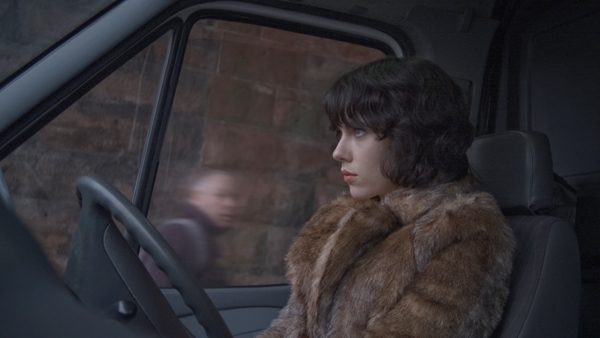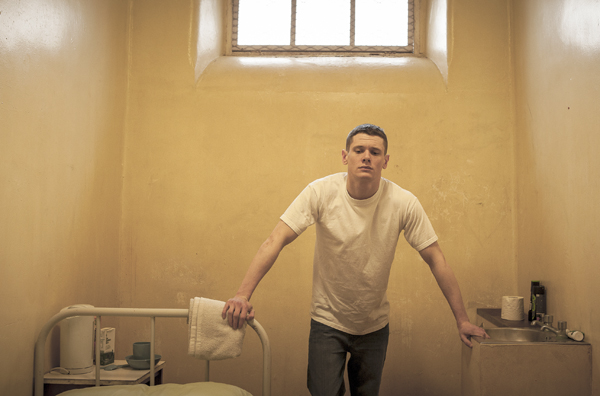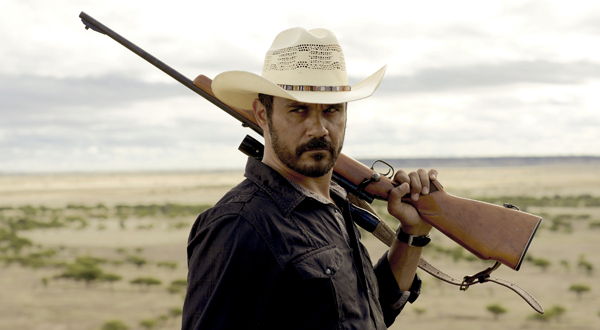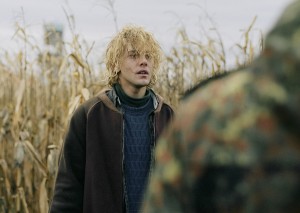Claire Stewart’s second year at the London Film Festival helm set sail with the European premiere of Paul Greengrass’s Captain Philips and ended with the world premiere of John Lee Hancock’s Saving Mr. Banks, both beamed simultaneously by satellite to 30 towns and cities across the UK and Ireland. At the closing press conference, Tom Hanks, the lead in both films, joked that he’d been held captive in London and had been sleeping in the park for the entire festival.
Fortuitously for Hanks, London basked in glorious (and uncharacteristic) autumnal sunshine for a strong showing of 361 films under the varied sections titled Love, Debate, Dare, Thrill, Cult, Journey, Sonic, Family, Experimenta, and Treasures. These categories were introduced last year to traverse geographic and genre categories.
As the festival came to a close, the jury honored Ida, by Pawel Pawlikowski, as the best film in the official competition among strong and diverse contenders. After a career in documentaries, Polish director Pawlikowski came to prominence in Britain with the features The Stringer, The Last Resort and My Summer of Love. Ida, his first film made in his native Poland, is set in 1962.
Before she can take her vows, Anna, an introverted, orphaned novice brought up in a convent, visits her last living relative, her estranged Aunt Wanda, a notorious postwar judge. Wanda is Anna’s polar opposite; an independent single women and member of the communist intelligentsia. Wanda reveals that Anna is Jewish by birth and takes her to their hometown to uncover the fate and final resting place of their family. Amid the fog of Wanda’s cigarette smoke, booze, and casual sexual encounters, the pair attempt to reconcile the past with the present while searching for a reason to live. With understated performances, Pawlikowski delivers a meditative, exploration of the painful legacy of the German occupation that has a lasting emotional resonance.
Although it missed out on the official competition’s top award, David Mackenzie’s Starred Up garnered the Best British Newcomer prize for screenwriter Jonathan Asser. Asser, an award-winning psychotherapist, drew on his experience working with violent inmates in a UK prison to write his first screenplay.
Nineteen-year-old Eric Love (Jack O’Connell) has been “starred up,” entering an adult prison two years early because of his explosive violent behavior. After years in institutions, Eric trusts no one. Immediately on the offensive, he assaults the screws and inmates. Marked as unwanted “trouble” by both the officers and the prison mafia, Eric is ignorant of their collusion. Confronted by his absent father, Neville (Ben Mendelsohn), a long-term fellow con who has been assigned to keep his son in line, Eric resents his father’s authority, unaware of the danger.
Starred Up is a brutal assault on the senses that just keeps ramping up the adrenalin. While underlying the central relationship, the incredible script provides a critique of a corrupt justice system and its collective failure to rehabilitate. Shot documentary style on location in a disused prison, director David Mackenzie conveys the intense claustrophobia and volatility with tight framing and a dynamic handheld camera. Lead actor O’Connell gives a brave and formidable performance that steals the film, if not the festival. Starred Up is an intense, authentic, and raw film that is a must-see.
The Double, British director Richard Ayoade’s follow up to his first feature Submarine, is an adaptation of Dostoevsky’s 19th-century novella of the same name. Co-written by Ayoade and Avi Korine (brother of director Harmony), the story centers on a worker at a data processing company, Simon James (Jesse Eisenberg). Despite being intelligent, hardworking, and conscientious, Simon is a diffident, perpetually apologetic pushover. Lonely and henpecked by his disappointed mother, Simon is invisible to the object of his affections, copy room assistant Hannah (Mia Wasikowska). When new employee James Simon arrives, Simon is overwhelmed.
While James is Simon’s exact physical double, the pair are polar opposites in character. Feckless, manipulative and extroverted, James immediately claims Simon’s work as his own, charms the management, and rises meteorically up the promotional ladder. After James seduces Hannah, Simon acts to expose his Machiavellian double but is perpetually outmaneuvered. As James destroys Simon’s good name and social standing, Simon takes desperate measures.
Eisenberg gives an excellent performance in a complex role as both his trademark misfit and aggressive double with an excellent supporting cast that includes cameos from James Fox and Noah Taylor. Designer David Crank meticulously creates a timeless, dislocated world reminiscent of French directors Jean-Pierre Jeunet and Marc Caro, 1984 by Michael Radford, or Terry Gilliam’s Brazil. While Ayoade doesn’t mine the depths of the literary source and the ending doesn’t quite deliver on its promise, The Double is an ingenious production with some surreal visual comedy, great pace and dialogue.
Another competition contender was Mystery Road, written, directed, and shot by indigenous Australian Ivan Sen. His fourth feature stars Aaron Pederson as Jay Swan, a police office of mixed heritage who returns home to a depressed outback farming town and a difficult reunion with his alcoholic ex-wife and estranged teenage daughter. His first case involves the murder of Julie, an aboriginal teenager dumped under a highway bridge with her throat slit, amid rumors that she funded her drug habit selling sex to truckers. A lone outsider, Jay is stonewalled by the aboriginal community, subjected to racism by the white farmers, and denied resources by the alcoholic police chief. As more bodies are unearthed and Jay discovers the scrupulous officer he replaced was murdered, he suspects police collusion. When his daughter is linked to the victims, Jay acts alone, determined to protect her.
Sen has a great vision and an important cultural perspective. From the opening graphic, Mystery Road is visually striking. He captures the bleached beauty of the outback landscape and the dilapidated details of the community with languid aerial tracking shots. The visual accomplishment is, however, undermined by the screenplay. Pederson performance seems hampered by an underdeveloped character. The script’s dialogue-driven, convoluted plot does not quite connect the dots, losing the viewer and challenging credibility with an over-reliance on coincidence.
Also in the official competition, Rags and Tatters by Ahmad Abdalla follows one man during three nights of the first days of the Egyptian revolution in January 2011. It was inspired by Abdella’s experience volunteering at “The Media Camp,” a tent in Tahrir Square that collected mobile video during the sit-in of February 2011. When communication was cut across the country, volunteers uploaded the personal video captured by the population to the Internet and sent it to TV stations across the globe.
Abdalla has constructed a story that follows an anonymous lead character’s struggle to expose the events captured on a mobile phone. Waking up in a prison cell to riotous destruction, the lead escapes with his closest friend. Caught in gunfire, his friend gets shot. Leaving this friend alive in a cottage, he evades the authorities and journeys to his mother’s house, taking his friend’s mobile phone that contains footage of brutality during the prison break-in. Amid a communication blackout and the outbreak of sectarian conflict, this everyman navigates the provinces and the communities gripped by fear and confusion, to reach the media and broadcast the footage.
The film is shot using a camcorder to emulate mobile phone footage and amateur documentary videos that shaped our visual memory of the event. Abdalla exploits all the defects of the style, with long takes, shaky handheld shots, and the disadvantages of cheap digital lenses and Internet compression. In scenes constructed free from dialogue, Abdalla presents the events that take part either before or after any dialogue, relying on the images and the character dynamics to convey the narrative. Music is used sparingly. Sufi chants are only heard when the lead spends time among a Sufi community at a cemetery. The poetry of these chants provides reflective interludes and gives the film its title that refers to a Sufi chanting competition.
Rags and Tatters is evocative and meditative. Abdalla’s visual style achieves his goal of immersing the audience in the events with a character caught up in the revolution. That said, the deliberate anonymity of the characters and the structural conceit makes the relationships and finer narrative details difficult to discern and confusing.
Precocious Quebecois director Xavier Dolan’s feature Tom at the Farm is an adaptation of French-Canadian Michel Marc Bouchard’s play. At just 24 years of age, Dolan’s wrote, directed, edited, and stars in his fourth film that won the critics prize at Venice and competed in London.
City boy Tom (Dolan), a grief stricken young advertising copywriter, travels to the homophobic Canadian heartland to attend his lover Guillaume’s funeral. Stopping at the creaky farmstead where his partner grew up, he meets his boyfriend’s broken mother, Agathe (Lise Roy), and the brutish older brother, Francis (Pierre-Yves Cardinal). Tom’s shocked that Guillaume’s family don’t know who he is, or his significance to Guillaume. Although Tom maintains Agathe’s ignorance, Francis is suspicious and coerces Tom to construct an elaborate deception, invent a girlfriend for Guillaume, and to stay longer, all to please Agathe. Days turn into weeks as Tom is trapped in a sadomasochistic relationship with the psychopathic Francis.
Set in the rural panoramas of Quebec, Dolan’s psychological thriller about repression draws liberally on horror and psychological drama. He combines creaking interiors, an isolated farm, and familial madness with a score by Gabriel Yared that’s full of urgent strings, a knowing tribute to Bernard Herrmann’s work with Hitchcock. It’s a claustrophobic and gripping exercise in suspense that is punctuated by tonal shifts and moments of broader absurd comedy, like the coke-fuelled tango lessons in a barn, dirty talk in the kitchen, and a funeral playlist of pop songs. Despite forays into absurdity, Dolan grounds Tom in a stark aesthetic and the toil and dirt of the farmland. Although the drama is at times difficult to get into, burgeoning auteur Dolan delivers a confidently shot and carefully composed film with a precise sense of timing that elevates his sometimes heavy-handed references to familiar genre tropes.
Under the Skin by Jonathan Glazer, director of the brilliantly original gangster film Sexy Beast (2000), is the long awaited follow-up to his critically acclaimed but controversial 2004 supernatural thriller Birth. After nearly 10 years, Glazer returns with his most spectacular but potentially divisive film yet, a loose adaptation of Michel Faber’s science-fiction novel.
Scarlett Johansson plays Laura, an extra-terrestrial femme fatale who trawls the city streets of Glasgow in a white van seducing men. Unable to believe their luck, the guys are willing prey, unaware of what lies in store for them back at her lair. In a series of astonishing scenes, her reason for killing her conquests is revealed. When fearless Laura travels to the mist soaked wilds of the Scottish Highlands, seemingly in search of a home, she develops human emotions that make the previously empowered alien vulnerable to unsavory earthly characters.
Johansson barely utters a word except for her pick-up lines in a performance that is understated yet enthralling. Glazer captures her improvised pick-up scenes with random unsuspecting local non-professional actors using specially designed hidden cameras. (Paul Brannigan continues his meteoric rise after he was cast as a non-professional actor in Ken Loach’s The Angels’ Share.) The spontaneity of these interactions is a refreshing conceit that heightens the realism.
As the camera clandestinely stalks the streets, we view events through Laura’s eyes, alternately curious and detached, and the city is depicted so mundanely that the everyday normality becomes almost alien in itself. All shades of humanity, noble and ignoble, are captured in the ebb and flow among the eateries, shopping centers, nightclubs, and derelict buildings. Impressionistic sequences and painterly compositions punctuate the grounded realism in Laura’s “feeding” scenes. Mica Levi’s dissonant score amplifies the tension and terror.
Glazer’s enigmatic adaptation avoids the book’s explanations and its message, instead conveying an intriguing bold vision that is rich with potential readings. He skillfully marries realism with stunning original visuals and a touch of dark humor to subvert the sci-fi genre. Compelling viewing, Under the Skin will mesmerize and mystify in equal measure. To fully appreciate the immersive sound and image, watch it on the big screen.
With the sun shining, it was a fantastic festival with a host of notable premieres and gems. Amongst them, Alexander Payne’s Nebraska, Lukas Moodysson’s We Are the Best, and The Lunchbox by Ritesh Batra were charming character studies that seduced audiences. Steve McQueen’s deeply moving epic 12 Years a Slave received a heartfelt standing ovation at the UK premiere. That was given added resonance by coinciding with UK Anti-Slavery Day. At the premiere of Stephen Frears’s Philomena, striking firefighters grabbed headlines by breaking their protest to serenade Judi Dench. As the BFI launched their BFI Player, a new video-on-demand service that will give audiences the chance to watch the BFI Archive, Claire Stewart offered a glimpse of the festival’s future.




















Leave A Comment